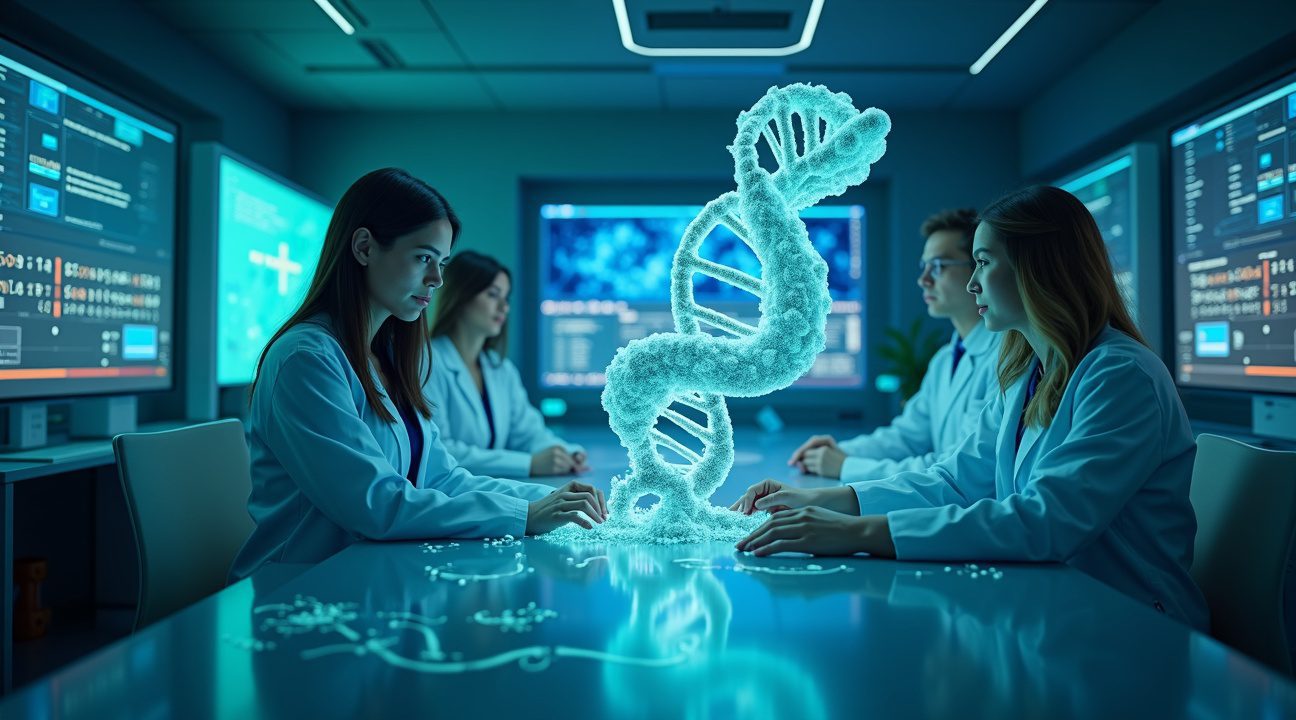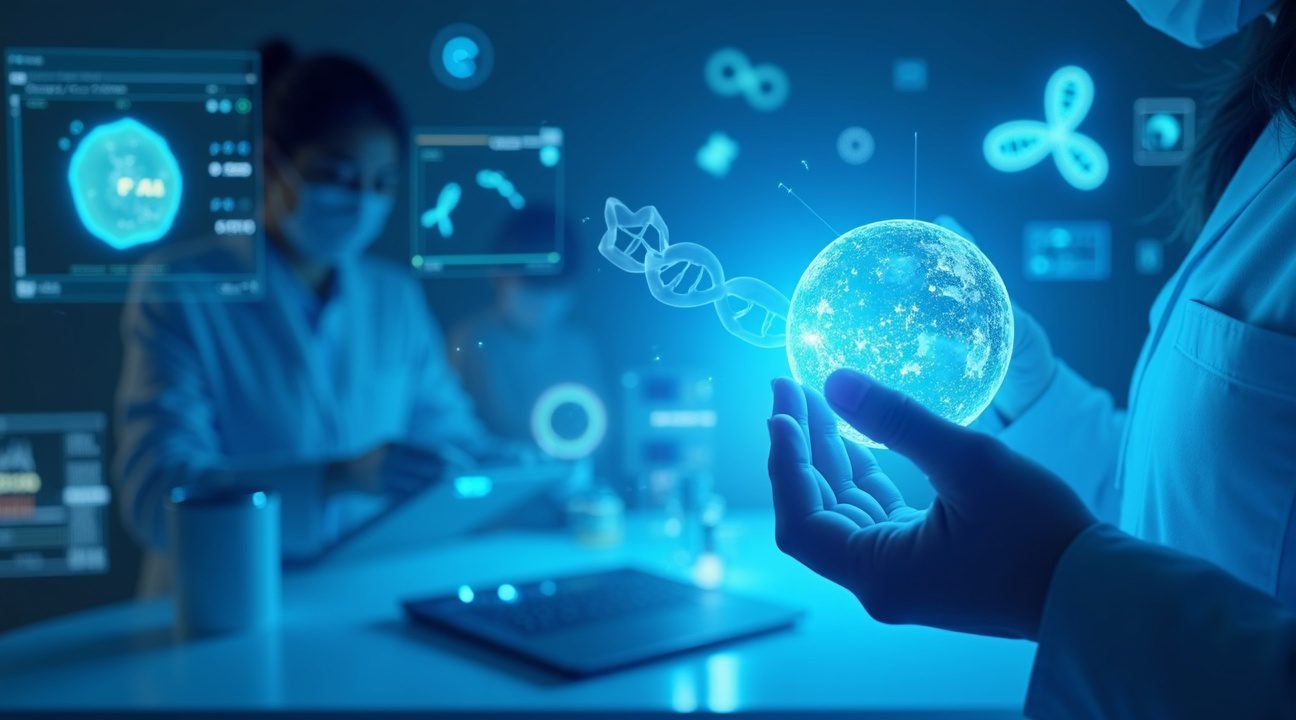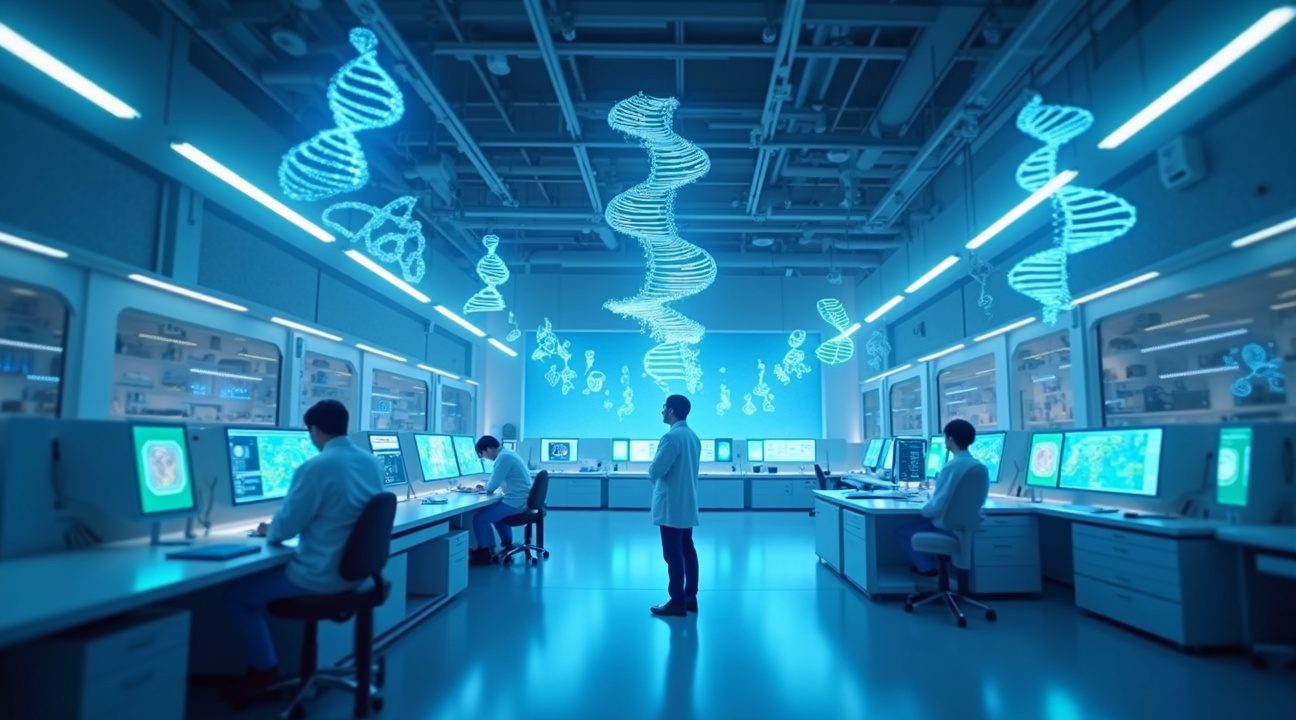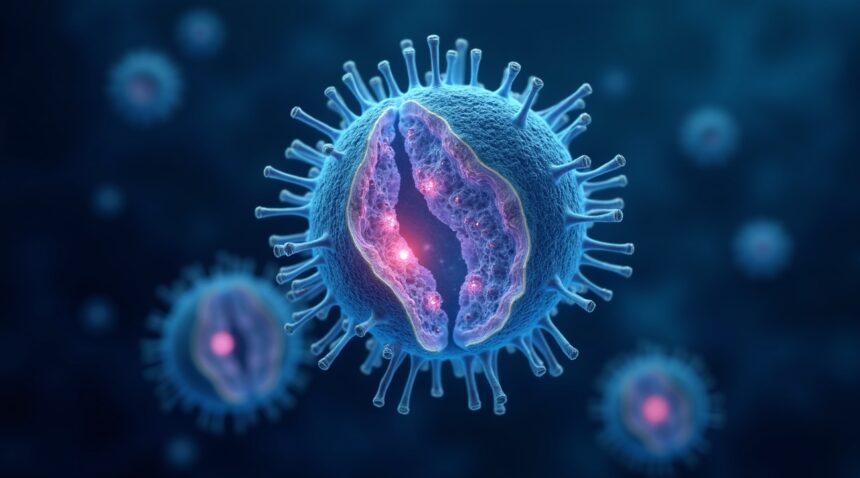Japanese researchers at Mie University have made a groundbreaking advance by using CRISPR-Cas9 gene editing technology to successfully remove the additional chromosome 21, which causes Down syndrome, from human cells.
Key Takeaways
- Scientists achieved chromosome 21 removal from human cells using CRISPR-Cas9, with elimination rates reaching up to 37.5% under optimal laboratory conditions.
- Corrected cells demonstrated substantial improvements including accelerated growth, normalized gene expression profiles, and enhanced cellular functionality comparable to non-trisomic cells.
- The method proved effective across diverse cell types such as pluripotent stem cells and skin fibroblasts, indicating the potential for wide-ranging therapeutic applications.
- Research is currently limited to in vitro experiments, and comprehensive safety evaluations are essential before considering clinical applications.
- This advancement sparks deep ethical discussions about genetic diversity, disability rights, and the implications of modifying human DNA, even as it provides hope for future Down syndrome therapies.
The Science Behind “Trisomic Rescue”
CRISPR-Cas9 Technology Explained
CRISPR-Cas9 is a revolutionary gene-editing tool that allows scientists to selectively edit specific parts of the genome with remarkable precision. It utilizes a guide RNA to direct the Cas9 enzyme to a target DNA sequence, where it can make a precise cut to remove or replace genetic material.
Application to Down Syndrome Cells
In this study, scientists applied CRISPR-Cas9 to target and remove the extra chromosome 21 found in cells affected by Down syndrome. The “trisomic rescue” technique carefully deleted the surplus chromosome without damaging the remaining, necessary chromosomes. The cells that underwent this correction showed clear signs of improved biological function.
Ethical Considerations
While this innovation offers a glimpse of future treatment possibilities, it also raises important ethical issues. Critics argue that altering fundamental aspects of human biology could reduce genetic diversity and affect societal perceptions of disability and inclusion. These concerns must be carefully weighed as research progresses.
For readers interested in learning more about CRISPR and its ethical implications, the [National Human Genome Research Institute](https://www.genome.gov) offers a wealth of information.
CRISPR-Cas9 Gene Editing Achieves “Trisomic Rescue” in Human Cells
Scientists at Mie University in Japan have achieved a groundbreaking advancement in genetic editing by successfully removing the extra chromosome 21 responsible for Down syndrome from human cells. Dr. Ryotaro Hashizume and his team published their findings in PNAS Nexus in February 2025, demonstrating that CRISPR-Cas9 technology can perform what researchers call “trisomic rescue” — the precise elimination of only the surplus chromosome while preserving the normal chromosome pair.
The innovative methodology centers on allele-specific editing guides that direct the Cas9 enzyme to identify and target exclusively the extra chromosome 21. This precision approach significantly reduces the risk of damaging healthy chromosomes during the editing process. This level of specificity is particularly impressive, as it addresses one of the primary concerns with genetic editing — unintended effects on normal cellular components.
Enhanced Efficiency Through DNA Repair Suppression
The research team’s results varied depending on the specific conditions employed during the editing process. Baseline chromosome elimination rates reached 13.1%, but the scientists discovered they could dramatically improve effectiveness by temporarily suppressing DNA repair pathways. This modification pushed elimination rates to a maximum of 37.5%, representing nearly a threefold increase in efficiency.
Testing occurred across multiple cell types, including pluripotent stem cells and skin fibroblasts derived from individuals with Down syndrome. The technique demonstrated success across all surveyed cell types, suggesting broad applicability beyond initial laboratory conditions. This versatility could prove crucial for future therapeutic applications, as different tissues may require distinct approaches for optimal results.
The CRISPR-Cas9 system’s ability to achieve somatic cell correction opens possibilities for treating existing conditions rather than solely preventing them. While scientists think they’ve discovered various mechanisms behind neurological conditions, this particular breakthrough focuses on chromosomal intervention at the cellular level.
Current research remains in laboratory stages, with testing limited to cultured human cells rather than living organisms. The elimination rates, while promising, still require optimization before potential clinical applications. Scientists continue refining the allele-specific editing guides to improve both precision and efficiency while maintaining cellular viability throughout the editing process.

Corrected Cells Show Dramatic Improvements in Growth and Function
The cellular improvements following chromosome correction proved remarkable across multiple biological functions. Gene expression patterns in the corrected cells matched those found in typical, non-trisomic cells, essentially restoring normal cellular behavior at the molecular level.
Enhanced Cellular Performance Metrics
The corrected cells demonstrated several key improvements that highlight the technique’s potential impact:
- Faster cell growth rates compared to uncorrected trisomic cells
- Reduced division time, allowing for more efficient cellular reproduction
- Normalized antioxidant capacity, improving cellular defense against oxidative stress
- Restoration of typical protein manufacturing patterns essential for cellular function
These improvements suggest that removing the extra chromosome doesn’t just address the genetic imbalance—it actively restores cellular vitality and function to levels seen in typical cells.
Neural Development and Metabolic Changes
Perhaps most significantly, the research revealed specific changes in gene activity patterns that could have profound implications for future treatments. Genes involved in nervous system development became more active in the corrected cells, while genes related to metabolic activity showed reduced expression. This shift hints at the possibility that scientists think this approach could eventually benefit neural development therapies.
The technique’s versatility became apparent when researchers tested it on different cell types. Both dividing cells and nondividing (differentiated) human cells responded positively to the chromosome removal process. This broad applicability suggests the method could potentially work across various tissue types, opening doors for applications beyond what researchers initially imagined.
The restoration of normal gene expression patterns represents a fundamental breakthrough in understanding how chromosome abnormalities affect cellular function. When cells no longer carry the burden of extra genetic material, they can redirect their resources toward normal growth and development processes. This cellular rejuvenation could prove crucial for developing future therapeutic interventions that go beyond prevention to actual treatment of existing conditions.
The fact that both actively dividing and mature, specialized cells showed improvements indicates the technique’s potential reaches across different stages of cellular development and various organ systems throughout the body.
Revolutionary Approach Targets Root Cause of World’s Most Common Chromosomal Disorder
Down syndrome represents the most common chromosomal disorder, affecting approximately 1 in every 700 births globally. This condition results from an extra copy of chromosome 21, creating a range of developmental challenges and health complications that have traditionally been managed through symptom treatment rather than addressing the underlying genetic cause.
Japanese researchers have developed a groundbreaking technique that directly targets this extra chromosome, marking a significant departure from conventional approaches. Instead of focusing solely on managing the symptoms or associated medical complications, this innovative method addresses the root cause of the condition itself. The technique demonstrates the potential to remove the additional chromosome 21 that creates the characteristic features and health challenges associated with Down syndrome.
Transformative Applications on the Horizon
The implications of this research extend far beyond laboratory demonstrations. Future applications could revolutionize prevention strategies if the technology advances to early embryonic or preimplantation stages. Scientists exploring similar breakthroughs have made remarkable discoveries about genetic manipulation, much like researchers who’ve investigated DNA recreation in other contexts.
Early intervention at the embryonic level could potentially prevent Down syndrome births entirely, offering families new reproductive options. This approach represents a fundamental shift from current prenatal screening methods that primarily provide information for decision-making rather than therapeutic solutions.
Additionally, the technique opens possibilities for treating living individuals through somatic cell correction. While still in early stages, this application could potentially address or reduce symptoms in people currently living with Down syndrome. The ability to correct cells after birth introduces hope for improving quality of life and addressing specific health complications associated with the condition.
The research builds on decades of genetic understanding and represents a convergence of advanced gene editing technologies with precise chromosomal manipulation. Unlike previous attempts that focused on individual genes, this approach tackles the entire extra chromosome responsible for the condition’s diverse manifestations.
Scientists continue refining the methodology to ensure safety and efficacy before any clinical applications. The complexity of chromosomal manipulation requires extensive testing to prevent unintended consequences while maximizing therapeutic benefits. Research teams worldwide are closely monitoring these developments, as similar techniques could potentially address other chromosomal disorders beyond Down syndrome.
This breakthrough represents more than scientific achievement—it offers genuine hope for families affected by chromosomal disorders. As researchers continue developing and testing these methods, the possibility of preventing or treating Down syndrome moves closer to clinical reality, potentially transforming lives for generations to come.

Ethical Questions Emerge as Technology Advances
I find myself grappling with profound questions about genetic intervention as this groundbreaking research unfolds. The ability to remove chromosomes responsible for Down syndrome raises fundamental concerns about our role in shaping human genetic diversity. Critics argue that eliminating genetic variations could diminish the rich tapestry of human experience and potentially devalue individuals who currently live with these conditions.
Balancing Innovation with Genetic Diversity
Society faces a critical crossroads in determining how far genetic intervention should extend. Some ethicists worry that widespread chromosome removal could create pressure on families to eliminate genetic differences, potentially leading to a less diverse human population. This technology might inadvertently send a message that certain genetic conditions are inherently undesirable, which conflicts with disability rights advocates who emphasize the value and dignity of all human lives.
The precision required for safe chromosome removal remains a significant concern. Current laboratory techniques carry risks of unintended genetic modifications that could affect healthy cells or create new complications. I’ve observed how scientists think they’ve discovered complex biological mechanisms, yet unforeseen consequences often emerge in genetic research.
Clinical Readiness and Safety Considerations
The research remains firmly in the laboratory phase, far from clinical application. Scientists acknowledge that extensive efficacy and safety testing must occur before considering human trials. Researchers need to address several critical factors:
- Long-term effects on cellular function and development
- Potential complications from incomplete chromosome removal
- Impact on other genetic pathways and cellular processes
- Verification of treatment precision across different cell types
The technology’s current limitations prevent immediate clinical use, requiring years of additional research to ensure safety. I recognize that breakthrough discoveries like this often face similar challenges to those seen in other genetic research, such as studies exploring whether we can recreate dinosaurs from their DNA. The gap between laboratory success and practical application typically spans decades rather than years.
These ethical considerations will likely shape regulatory frameworks and public policy as the technology advances. The scientific community must balance the potential to prevent genetic conditions with respect for human diversity and individual choice.
Major Hurdles Remain Before Clinical Application
The breakthrough achieved by Japanese researchers represents only the first step in a lengthy journey toward clinical implementation. Currently, scientists have successfully removed the extra chromosome 21 from laboratory-grown human cells, but this achievement doesn’t translate directly to real-world medical applications.
Critical Technical Limitations
Several significant challenges must be addressed before this technology can benefit patients:
- Laboratory cell cultures behave differently than living organisms, making it unclear how the technique would perform in actual human tissues
- The process hasn’t been tested on embryos or the diverse range of cell types affected by Down syndrome throughout the body
- Researchers haven’t demonstrated the ability to target specific tissues while leaving others unchanged
- Current efficiency rates remain too low for practical medical use
Unintended genetic alterations pose perhaps the greatest concern for future clinical development. While scientists have shown they can remove the problematic chromosome, they’re still working to prevent accidental changes to other parts of the genome. These off-target effects could potentially cause new health problems, making the treatment more dangerous than beneficial.
The complexity increases when considering that Down syndrome affects multiple organ systems throughout the body. Brain development, heart function, immune system responses, and numerous other biological processes all involve the extra genetic material. Scientists must prove they can safely modify cells across all these different tissue types without disrupting normal cellular function.
Researchers are now focusing their efforts on improving the precision of their targeting mechanisms. They’re developing better tools to ensure the chromosome removal process affects only the intended genetic material. Scientists think enhanced accuracy will be crucial for moving from laboratory success to clinical reality.
Efficiency improvements represent another major research priority. Current methods work in only a small percentage of treated cells, which wouldn’t be sufficient for therapeutic applications. Future developments must achieve much higher success rates while maintaining safety standards.
Safety protocols for any eventual clinical trials will require extensive validation. Researchers must demonstrate not only that the technique works but also that it doesn’t cause harmful side effects months or years after treatment. This comprehensive safety testing process typically takes many years to complete.
The timeline for clinical application remains uncertain, as each of these hurdles requires significant scientific advances. While the initial breakthrough offers hope for families affected by Down syndrome, translating laboratory success into safe, effective treatments will require continued research and development across multiple scientific disciplines.

Future Research Directions and Medical Implications
Japanese researchers have opened new pathways for genetic intervention, yet significant work remains before these techniques reach clinical application. Current efficiency rates hover around 37.5%, indicating substantial room for improvement in precision targeting mechanisms.
Enhancing Precision and Efficiency
Scientists must focus on refining CRISPR-Cas9 gene editing protocols to achieve more reliable chromosome 21 elimination outcomes. Allele-specific editing techniques require further development to ensure complete trisomy 21 correction without affecting healthy genetic material. I observe that researchers are exploring advanced delivery systems and improved guide RNA design to boost success rates. Enhanced precision tools could potentially revolutionize how medical professionals approach chromosome rescue procedures.
The challenge extends beyond simple efficiency metrics. Researchers need to develop comprehensive safety protocols before advancing to human trials. This includes extensive testing in various cell lines and animal models to understand long-term effects of chromosome manipulation. Establishing these protocols will likely take years of careful validation.
Clinical Applications and Treatment Possibilities
Future applications could span multiple treatment approaches, each offering unique therapeutic potential. These emerging techniques present several promising directions:
- Preimplantation diagnosis enhancement through direct chromosome correction rather than selection
- Somatic cell correction in living individuals with Down syndrome
- Prevention strategies for high-risk pregnancies
- Gene therapy applications for cognitive and developmental improvements
- Therapeutic interventions for associated medical conditions
Somatic cell correction represents perhaps the most ambitious goal, potentially offering treatment options for individuals already living with the condition. Scientists are investigating whether chromosome rescue techniques could address some developmental challenges associated with Down syndrome. However, the complexity of brain development and established neural pathways presents significant hurdles.
Research teams are also exploring how these techniques might integrate with existing preimplantation diagnosis procedures. Rather than selecting embryos without genetic conditions, doctors could potentially correct chromosomal abnormalities before implantation. This approach raises important questions about genetic diversity and the broader implications of chromosome-level editing.
The path forward requires careful consideration of ethical frameworks alongside technical advancement. While scientists think they’ve discovered various genetic mechanisms, applying this knowledge responsibly demands extensive collaboration between researchers, ethicists, and medical professionals. Success in chromosome 21 elimination could pave the way for addressing other chromosomal conditions, though each presents unique challenges requiring specialized approaches.

Sources:
Genetic Literacy Project: “Can gene editing eliminate Down syndrome? Scientists have done it in lab-grown cells”
MedTour.Help: “Japanese scientists have developed a method for removing the chromosome associated with Down syndrome”
Mie University: “Innovative Approach Developed for Removing Extra Chromosome 21 in Cells from Individuals with Down Syndrome”
Conexiant: “CRISPR Successfully Removes Extra Chromosome 21”
CRISPR Medicine News: “CMN Weekly (21 February 2025) – CRISPR Medicine News”
PNAS Nexus: “Trisomic rescue via allele-specific multiple chromosome cleavage using CRISPR-Cas9 in trisomy 21 cells”
Earth.com: “CRISPR used to remove extra chromosomes in Down syndrome and restore cell function”


